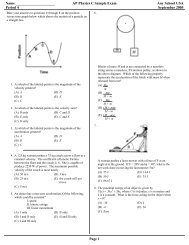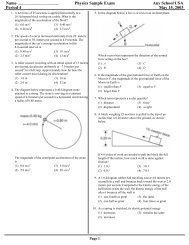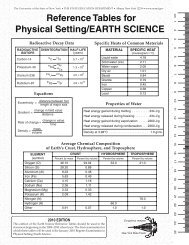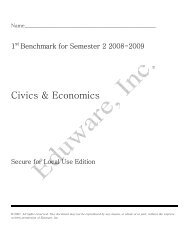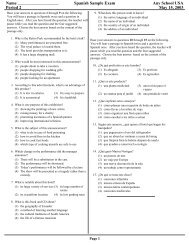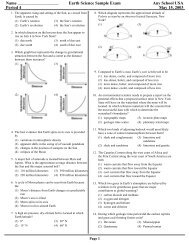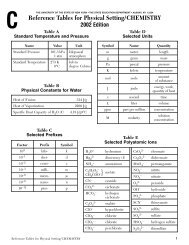NYS Regents Chemistry June 21, 2002 - Eduware
NYS Regents Chemistry June 21, 2002 - Eduware
NYS Regents Chemistry June 21, 2002 - Eduware
Create successful ePaper yourself
Turn your PDF publications into a flip-book with our unique Google optimized e-Paper software.
1. What is the electron configuration of a sulfur atom in the<br />
ground state<br />
(A) 2–4 (C) 2–8–4<br />
(B) 2–6 (D) 2–8–6<br />
<strong>NYS</strong> <strong>Regents</strong> <strong>Chemistry</strong><br />
<strong>June</strong> <strong>21</strong>, <strong>2002</strong><br />
11. Which of the following atoms has the greatest tendency to<br />
attract electrons<br />
(A) barium<br />
(C) boron<br />
(B) beryllium<br />
(D) bromine<br />
2. The modern model of the atom shows that electrons are<br />
(F) orbiting the nucleus in fixed paths<br />
(G) found in regions called orbitals<br />
(H) combined with neutrons in the nucleus<br />
(J) located in a solid sphere covering the nucleus<br />
3. Which compound contains ionic bonds<br />
(A) NO<br />
(C) CaO<br />
(B) NO 2<br />
(D) CO 2<br />
4. All the isotopes of a given atom have<br />
(F) the same mass number and the same atomic number<br />
(G) the same mass number but different atomic numbers<br />
(H) different mass numbers but the same atomic number<br />
(J) different mass numbers and different atomic numbers<br />
12. Which 5.0-milliliter sample of NH 3<br />
will take the shape of<br />
and completely fill a closed 100.0-milliliter container<br />
(F) NH 3<br />
(s)<br />
(H) NH 3<br />
(g)<br />
(G) NH 3<br />
(…) (J) NH 3<br />
(aq)<br />
13. The strongest forces of attraction occur between molecules<br />
of<br />
(A) HCl<br />
(C) HBr<br />
(B) HF<br />
(D) HI<br />
14. Which graph shows the pressure-temperature relationship<br />
expected for an ideal gas<br />
(F)<br />
(H)<br />
5. What are two properties of most nonmetals<br />
(A) high ionization energy and poor electrical conductivity<br />
(B) high ionization energy and good electrical<br />
conductivity<br />
(C) low ionization energy and poor electrical conductivity<br />
(D) low ionization energy and good electrical conductivity<br />
6. Which element is classified as a noble gas at STP<br />
(F) hydrogen<br />
(H) neon<br />
(G) oxygen (J) nitrogen<br />
7. The percent by mass of hydrogen in NH 3<br />
is equal to<br />
(A) 17<br />
1<br />
× 100 (C) 1<br />
17 × 100<br />
(B) 17<br />
3 × 100 (D) 3<br />
17 × 100<br />
(G)<br />
(J)<br />
8. Metallic bonding occurs between atoms of<br />
(F) sulfur<br />
(H) fluorine<br />
(G) copper (J) carbon<br />
9. Atoms of the same element that have different numbers of<br />
neutrons are classified as<br />
(A) charged atoms<br />
(C) isomers<br />
(B) charged nuclei<br />
(D) isotopes<br />
10. Compared to the radius of a chlorine atom, the radius of a<br />
chloride ion is<br />
(F) larger because chlorine loses an electron<br />
(G) larger because chlorine gains an electron<br />
(H) smaller because chlorine loses an electron<br />
(J) smaller because chlorine gains an electron<br />
15. At the same temperature and pressure, which sample<br />
contains the same number of moles of particles as 1 liter of<br />
O 2<br />
(g)<br />
(A) 1 L Ne(g)<br />
(C) 0.5 L SO 2<br />
(g)<br />
(B) 2 L N 2<br />
(g)<br />
(D) 1 L H 2<br />
O(…)<br />
16. Which change in the temperature of a 1-gram sample of<br />
water would cause the greatest increase in the average<br />
kinetic energy of its molecules<br />
(F) 1°C to 10°C (H) 50°C to 60°C<br />
(G) 10°C to 1°C (J) 60°C to 50°C<br />
17. Which compound is classified as a hydrocarbon<br />
(A) ethane<br />
(C) chloroethane<br />
(B) ethanol<br />
(D) ethanoic acid<br />
Page 1
18. Given the reaction:<br />
Mg(s) + 2 H + (aq) + 2 Cl – (aq) →<br />
Mg 2+ (aq) + 2 Cl – (aq) + H 2<br />
(g)<br />
Which species undergoes oxidation<br />
(F) Mg(s)<br />
(H) Cl – (aq)<br />
(G) H + (aq) (J) H 2<br />
(g)<br />
19. Which formula is an isomer of butane<br />
(A)<br />
(C)<br />
<strong>NYS</strong> <strong>Regents</strong> <strong>Chemistry</strong><br />
26. Which ion is produced when an Arrhenius base is<br />
dissolved in water<br />
(F) H + , as the only positive ion in solution<br />
(G) H 3<br />
O + , as the only positive ion in solution<br />
(H) OH – , as the only negative ion in solution<br />
(J) H – , as the only negative ion in solution<br />
27. The change that is undergone by an atom of an element<br />
made radioactive by bombardment with high-energy<br />
protons is called<br />
(A) natural transmutation (C) natural decay<br />
(B) artificial transmutation (D) radioactive decay<br />
(B)<br />
(D)<br />
28. As ice melts at standard pressure, its temperature remains<br />
at 0°C until it has completely melted. Its potential energy<br />
(F) decreases<br />
(H) remains the same<br />
(G) increases<br />
29. As a sample of the radioactive isotope 131 I decays, its<br />
half-life<br />
(A) decreases<br />
(C) remains the same<br />
(B) increases<br />
20. Which particles are gained and lost during a redox<br />
reaction<br />
(F) electrons<br />
(H) neutrons<br />
(G) protons (J) positrons<br />
<strong>21</strong>. What is the oxidation number of chromium in K 2<br />
Cr 2<br />
O 7<br />
<br />
(A) +12 (C) +3<br />
(B) +2 (D) +6<br />
22. Which process requires an external power source<br />
(F) neutralization<br />
(H) fermentation<br />
(G) synthesis (J) electrolysis<br />
23. A substance that conducts an electrical current when<br />
dissolved in water is called<br />
(A) a catalyst<br />
(C) a nonelectrolyte<br />
(B) a metalloid<br />
(D) an electrolyte<br />
24. Which product of nuclear decay has mass but no charge<br />
(F) alpha particles<br />
(H) gamma rays<br />
(G) neutrons (J) beta positrons<br />
25. Given the reaction:<br />
HCl(aq) + LiOH(aq) → HOH(…)+ LiCl(aq)<br />
30. As an atom becomes an ion, its mass number<br />
(F) decreases<br />
(H) remains the same<br />
(G) increases<br />
31. In which shell are the valence electrons of the elements in<br />
Period 2 found<br />
(A) 1 (C) 3<br />
(B) 2 (D) 4<br />
32. Which of the following Group 15 elements has the greatest<br />
metallic character<br />
(F) nitrogen<br />
(H) antimony<br />
(G) phosphorus (J) bismuth<br />
33. The number of neutrons in the nucleus of an atom can be<br />
determined by<br />
(A) adding the atomic number to the mass number<br />
(B) subtracting the atomic number from the mass number<br />
(C) adding the mass number to the atomic mass<br />
(D) subtracting the mass number from the atomic number<br />
34. A compound has a gram formula mass of 56 grams per<br />
mole. What is the molecular formula for this compound<br />
(F) CH 2<br />
(H) C 3<br />
H 6<br />
(G) C 2<br />
H 4<br />
(J) C 4<br />
H 8<br />
The reaction is best described as<br />
(A) neutralization<br />
(C) decomposition<br />
(B) synthesis<br />
(D) oxidation-reduction<br />
Page 2
35. Given the equilibrium reaction at STP:<br />
N 2<br />
O 4<br />
(g) ↔ 2 NO 2<br />
(g)<br />
<strong>NYS</strong> <strong>Regents</strong> <strong>Chemistry</strong><br />
43. Given:<br />
Which statement correctly describes this system<br />
(A) The forward and reverse reaction rates are equal.<br />
(B) The forward and reverse reaction rates are both<br />
increasing.<br />
(C) The concentrations of N 2<br />
O 4<br />
and NO 2<br />
are equal.<br />
(D) The concentrations of N 2<br />
O 4<br />
and NO 2<br />
are both<br />
increasing.<br />
Which diagram represents a mixture<br />
(A)<br />
(C)<br />
36. What is the total number of oxygen atoms in the formula<br />
MgSO 4<br />
• 7 H 2<br />
O [The • represents seven units of H 2<br />
O<br />
attached to one unit of MgSO 4<br />
.]<br />
(F) 11 (H) 5<br />
(G) 7 (J) 4<br />
(B)<br />
(D)<br />
37. Given the reaction:<br />
6 CO 2<br />
+ 6 H 2<br />
O →C 6<br />
H 12<br />
O 6<br />
+ 6 O 2<br />
What is the total number of moles of water needed to make<br />
2.5 moles of C 6<br />
H 12<br />
O 6<br />
<br />
(A) 2.5 (C) 12<br />
(B) 6.0 (D) 15<br />
38. A student calculated the percent by mass of water in a<br />
hydrate as 14.2%. A hydrate is a compound that contains<br />
water as part of its crystal structure. If the accepted value is<br />
14.7%, the student’s percent error was<br />
0.5<br />
0.5<br />
×100 (H)<br />
(F) 14.2 0.5<br />
(G) 14.7<br />
14.2<br />
14.2⋅100 (J)<br />
14.7 ×100<br />
14.2<br />
14.7<br />
14.7⋅100<br />
39. Which of the following ions has the smallest radius<br />
(A) F –<br />
(C) K +<br />
(B) Cl –<br />
(D) Ca 40. According to Reference Table G, which solution is<br />
saturated at 30°C<br />
(F) 12 grams of KClO 3<br />
in 100 grams of water<br />
(G) 12 grams of KClO 3<br />
in 200 grams of water<br />
(H) 30 grams of NaCl in 100 grams of water<br />
(J) 30 grams of NaCl in 200 grams of water<br />
44. Which process is accompanied by a decrease in entropy<br />
(F) boiling of water (H) subliming of iodine<br />
(G) condensing of water vapor (J) melting of ice<br />
45. If 5.0 milliliters of a 0.20 M HCl solution is required to<br />
neutralize exactly 10. milliliters of NaOH, what is the<br />
concentration of the base<br />
(A) 0.10 M<br />
(C) 0.30 M<br />
(B) 0.20 M<br />
(D) 0.40 M<br />
46. Exactly how much time must elapse before 16 grams of<br />
potassium-42 decays, leaving 2 grams of the original<br />
isotope<br />
(F) 8 × 12.4 hours<br />
(H) 3 × 12.4 hours<br />
(G) 2 × 12.4 hours (J) 4 × 12.4 hours<br />
47. Which mass measurement contains four significant figures<br />
(A) 0.086 g<br />
(C) 1003 g<br />
(B) 0.431 g<br />
(D) 3870 g<br />
41. The gram formula mass of NH 4<br />
Cl is<br />
(A) 22.4 g/mole<br />
(C) 53.5 g/mole<br />
(B) 28.0 g/mole<br />
(D) 95.5 g/mole<br />
42. What is the molarity of a solution that contains 0.50 mole<br />
of NaOH in 0.50 liter of solution<br />
(F) 1.0 M<br />
(H) 0.25 M<br />
(G) 2.0 M (J) 0.50 M<br />
Page 3
48. Which pair of compounds are alcohols<br />
(F)<br />
<strong>NYS</strong> <strong>Regents</strong> <strong>Chemistry</strong><br />
51. Draw the electron-dot (Lewis) structure of an atom of<br />
calcium.<br />
(G)<br />
52. Draw the electron-dot (Lewis) structure of an atom of<br />
chlorine.<br />
(H)<br />
(J)<br />
53. Draw the electron-dot (Lewis) structure of calcium<br />
chloride.<br />
49. The process of joining many small molecules into larger<br />
molecules is called<br />
(A) neutralization<br />
(C) saponification<br />
(B) polymerization (D) substitution<br />
50. The diagram below represents a portion of a 100-milliliter<br />
graduated cylinder.<br />
What is the reading of the meniscus<br />
(F) 35.0 mL<br />
(H) 44.0 mL<br />
(G) 36.0 mL (J) 45.0 mL<br />
Page 4
54. A student is given two beakers, each containing an equal amount of clear, odorless liquid. One solution is acidic and the other is basic.<br />
a State two safe methods of distinguishing the acid solution from the base solution.<br />
b For each method, state the results of both the testing of the acid solution and the testing of the base solution.<br />
Base your answers to questions 55 and 56 on the information and diagram below, which represent the changes in potential energy that occur<br />
during the given reaction.<br />
Given the reaction: A + B → C<br />
<strong>NYS</strong> <strong>Regents</strong> <strong>Chemistry</strong><br />
55. a. Does the diagram illustrate an exothermic or an endothermic reaction<br />
b. State one reason, in terms of energy, to support your answer.<br />
56. On the diagram provided draw a dashed line to indicate a potential energy curve for the reaction if a catalyst is added.<br />
57. Given the reaction at equilibrium:<br />
N 2<br />
(g) + 3 H 2<br />
(g) ↔ 2 NH 3<br />
(g) + 92.05 kJ<br />
a. State the effect on the number of moles of N 2<br />
(g) if the temperature of the system is increased.<br />
b. State the effect on the number of moles of H 2<br />
(g) if the pressure on the system is increased.<br />
c. State the effect on the number of moles of NH 3<br />
(g) if a catalyst is introduced into the reaction system. Explain why this occurs.<br />
Base your answers to questions 58 through 60 on on the information below.<br />
In the modern model of the atom, each atom is composed of three major subatomic (or fundamental) particles.<br />
58. Name the subatomic particles contained in the nucleus of the atom.<br />
59. State the charge associated with each type of subatomic particle contained in the nucleus of the atom.<br />
60. What is the net charge of the nucleus<br />
Page 5
<strong>NYS</strong> <strong>Regents</strong> <strong>Chemistry</strong><br />
61. Base your answers to the following questions on the information given below.<br />
Testing of an unknown solid shows that it has the properties listed below.<br />
(1) low melting point<br />
(2) nearly insoluble in water<br />
(3) electricity<br />
(4) relatively soft solid<br />
a State the type of bonding that would be expected in the particles of this substance.]<br />
b Explain in terms of attractions between particles why the unknown solid has a low melting point.<br />
c Explain why the particles of this substance are nonconductors of electricity.<br />
62. Base your answers to the following questions on the information below.<br />
A hot pack contains chemicals that can be activated to produce heat. A cold pack contains chemicals that feel cold<br />
when activated.<br />
a Based on energy flow, state the type of chemical change that occurs in a hot pack.<br />
b A cold pack is placed on an injured leg. Indicate the direction of the flow of energy between the leg and the cold pack.<br />
c What is the Law of Conservation of Energy Describe how the Law of Conservation of Energy applies to the chemical reaction that<br />
occurs in the hot pack.<br />
63. The table below shows the electronegativity of selected elements of the Periodic Table.<br />
a On the grid set up a scale for electronegativity on the y-axis. Plot the data by drawing a best-fit line.<br />
b Using the graph, predict the electronegativity of nitrogen. _________________<br />
c For these elements, state the trend in electronegativity in terms of atomic number.<br />
Base your answers to questions 64 through 69 on the following redox reaction, which occurs spontaneously.<br />
64. Write the half-reaction for the reduction that occurs.<br />
65. Write the half-reaction for the oxidation that occurs.<br />
Zn + Cr 3+ → Zn 2+ +Cr<br />
Page 6
66. Balance the equation using the smallest whole-number coefficients.<br />
67. Which species loses electrons and which species gains electrons<br />
68. Which half-reaction occurs at the cathode<br />
<strong>NYS</strong> <strong>Regents</strong> <strong>Chemistry</strong><br />
69. State what happens to the number of protons in a Zn atom when it changes to Zn 2+ as the redox reaction occurs.<br />
Page 7
<strong>NYS</strong> <strong>Regents</strong> <strong>Chemistry</strong><br />
<strong>June</strong> <strong>21</strong>, <strong>2002</strong><br />
1. _________ D<br />
2. _________ G<br />
3. _________ C<br />
4. _________ H<br />
5. _________ A<br />
6. _________ H<br />
7. _________ D<br />
8. _________ G<br />
9. _________ D<br />
10. _________ G<br />
11. _________ D<br />
12. _________ H<br />
13. _________ B<br />
14. _________ F<br />
15. _________ A<br />
16. _________ H<br />
17. _________ A<br />
18. _________ F<br />
19. _________ D<br />
20. _________ F<br />
<strong>21</strong>. _________ D<br />
22. _________ J<br />
Answer Key<br />
31. _________ B<br />
32. _________ J<br />
33. _________ B<br />
34. _________ J<br />
35. _________ A<br />
36. _________ F<br />
37. _________ D<br />
38. _________ H<br />
39. _________ A<br />
40. _________ F<br />
41. _________ C<br />
42. _________ F<br />
43. _________ B<br />
44. _________ G<br />
45. _________ A<br />
46. _________ H<br />
47. _________ C<br />
48. _________ F<br />
49. _________ B<br />
50. _________ F<br />
51.<br />
23. _________ D<br />
24. _________ G<br />
52.<br />
25. _________ A<br />
26. _________ H<br />
27. _________ B<br />
53.<br />
28. _________ G<br />
29. _________ C<br />
30. _________ H
<strong>NYS</strong> <strong>Regents</strong> <strong>Chemistry</strong><br />
<strong>June</strong> <strong>21</strong>, <strong>2002</strong><br />
Answer Key<br />
54. a. Examples: -Test with an indicator. -Use Ph paper. -Check for<br />
creativity.<br />
b. Examples: -The base will turn phenolphthalein pink; the acid will<br />
not.<br />
-The acid will turn blue litmus paper red, and the base will turn red<br />
litmus paper blue.<br />
-Bromthymol blue will turn yellow in the acid and blue in the base.<br />
-The acid will react with an active metal like magnesium; the base<br />
will not.<br />
-The acid will have a pH less than 7; the base will have a pH greater<br />
than 7.<br />
55. a. Endothermic<br />
b. Examples: -PE of product C is greater than PE of reactants A and<br />
B.<br />
-Product C absorbed energy and is at a higher PE than reactants A and<br />
B.<br />
56.<br />
b Examples: – Energy flows from the injured leg to the cold pack. –<br />
Heat flows from the higher temperature (the leg) to the lower<br />
temperature (the cold pack). – The cold pack absorbs heat energy<br />
from the injured leg.<br />
c – The energy released from the hot pack is equal to the energy<br />
absorbed by the surroundings. – The total energy of the system<br />
(the hot pack) is equal to the total energy of the surroundings. –<br />
Everything else is constant.<br />
63.<br />
57. a. The number of moles of N 2 (g) increases or more N 2 (g) is made.<br />
b. The number of moles of H 2<br />
(g) decreases, less H 2<br />
(g) is made, or<br />
more H 2<br />
(g) is consumed.<br />
c. There is no effect on the production of NH 3<br />
(g) or that the number<br />
of moles remains the same.<br />
64.<br />
b The electonegativity of nitrogen is 3.0 ()0.2).<br />
c Example: -Atomic number increases—electronegativity<br />
increases.<br />
and<br />
65.<br />
Acceptable responses include, but are not limited to, these examples:<br />
-A catalyst increases the rate of both the forward and the reverse<br />
reactions equally.<br />
-The equilibrium point is reached faster.<br />
-A catalyst does not affect the concentrations of reactants or products.<br />
58. protons and neutrons<br />
59. Protons are positively charged (+) and neutrons have no charge (0).<br />
60. positive or (+)<br />
66.<br />
61. a covalent or molecular or nonpolar covalent<br />
b Examples: -The intermolecular attractions between the particles of<br />
the solid are weak. -Weak intermolecular attractions.<br />
c Example: -There are no freely moving charged particles<br />
62. a exothermic<br />
67. Zn (not Zn 2+ ) loses electrons and Cr 3+ (not Cr) gains electrons.<br />
68. 6e – + 2 Cr 3+ → 2 Cr or reduction or chromium half-reaction or Cr<br />
3+<br />
3+<br />
+ 3e – → Cr.
<strong>NYS</strong> <strong>Regents</strong> <strong>Chemistry</strong><br />
<strong>June</strong> <strong>21</strong>, <strong>2002</strong><br />
69. The number of protons remains the same or is unaffected.<br />
Answer Key
Category Print<br />
1: I. ATOMIC STRUCTURE\4. Electron Location/Energy\A. Bohr Model\1. Principal Energy Levels (Shells) - (2)<br />
2: I. ATOMIC STRUCTURE\3. Isotopes\A. Isotopes\1. Basic Definition - (4, 9)<br />
1: I. ATOMIC STRUCTURE\4. Electron Location/Energy\B. Energy\1. Principal Energy Levels - (1)<br />
1: I. ATOMIC STRUCTURE\2. Subatomic Particles\B. Mass\1. Atomic Mass / Mass Number - (33)<br />
18: I. ATOMIC STRUCTURE\5. Constructed Response\A. Constructed Response\1. Constructed Response - (51, 52, 53, 54, 55, 56, 57, 58,<br />
59, 60, 61, 62, 64, 65, 66, 67, 68, 69)<br />
1: II. PERIODIC TABLE\1. Properties of Elements\A. Metals\1. Metals - (32)<br />
2: II. PERIODIC TABLE\2. Valence Electrons\A. Electron / Ionic Configuration\2. Ionic Configuration - (10, 30)<br />
2: II. PERIODIC TABLE\4. Properties of Periods\C. Electronegativity\1. Electronegativity - (11, 13)<br />
1: II. PERIODIC TABLE\2. Valence Electrons\A. Electron / Ionic Configuration\1. Electron Configuration - (31)<br />
1: II. PERIODIC TABLE\1. Properties of Elements\C. Noble Gases\1. Noble Gases - (6)<br />
1: II. PERIODIC TABLE\4. Properties of Periods\B. Ionic Radius\1. Ionic Radius - (39)<br />
1: II. PERIODIC TABLE\1. Properties of Elements\B. Nonmetals\1. Nonmetals - (5)<br />
1: II. PERIODIC TABLE\6. Constructed Response\A. Constructed Response\1. Constructive Response - (63)<br />
1: III. MOLE/STOICHIOMETRY\4. Calculate Empirical / Molecular Formula\C. Percent Composition\1. Percent Composition - (7)<br />
2: III. MOLE/STOICHIOMETRY\3. Gram Formula Mass\A. Gram Formula Mass\1. Gram Formula Mass - (34, 41)<br />
1: III. MOLE/STOICHIOMETRY\3. Gram Formula Mass\A. Gram Formula Mass\2. Moles of Atoms in a Formula - (36)<br />
2: III. MOLE/STOICHIOMETRY\5. Math and Chemical Equations\D. Mole-Mole Problems\1. Mole - Mole Problems - (15, 37)<br />
1: IV. CHEMICAL BONDING\2. Bond Types\C. Metallic Bonding / Properties\1. Metallic Bonding / Properties - (8)<br />
1: IV. CHEMICAL BONDING\2. Bond Types\A. Ionic Bonding / Properties\1. Ionic Bonding - (3)<br />
1: IX. ACIDS, BASES AND SALTS\3. Reactions\A. Neutralization\1. Recognize Simple Reactions - (25)<br />
1: IX. ACIDS, BASES AND SALTS\2. Theories and Properties\A. Arrhenius Theory\1. Definitions - (26)<br />
1: IX. ACIDS, BASES AND SALTS\1. Electrolytes\A. Electrolytes\1. Definition / Concentration - (23)<br />
1: IX. ACIDS, BASES AND SALTS\3. Reactions\B. Acid-Base Titration\1. Calculate Conc. or Volume - (45)<br />
1: V. PHYSICAL BEHAVIOR OF MATTER\1. Energy\A. Heat (Thermal Energy)\1. Potential and Kinetic - (28)<br />
2: V. PHYSICAL BEHAVIOR OF MATTER\2. Properties of Gases\A. Ideal Gas Model (KMT)\1. Theory - (12, 14)<br />
1: V. PHYSICAL BEHAVIOR OF MATTER\5. Solutions\B. Saturation\2. Determine from Solubility Curve - (40)<br />
1: V. PHYSICAL BEHAVIOR OF MATTER\5. Solutions\C. Concentration\2. Molarity - (42)<br />
1: V. PHYSICAL BEHAVIOR OF MATTER\4. Mixtures\A. Types of Mixtures\1. Homogeneous / Heterogeneous - (43)<br />
1: V. PHYSICAL BEHAVIOR OF MATTER\1. Energy\B. Temperature\1. Average Kinetic Energy - (16)<br />
1: VI. KINETICS/EQUILIBRIUM\3. Equilibrium\A. Description\1. Properties of System - (35)<br />
1: VI. KINETICS/EQUILIBRIUM\4. Entropy\A. Descriptions and Understandings\1. Descriptions and Understandings - (44)<br />
1: VII. ORGANIC CHEMISTRY\1. Hydrocarbons\A. Hydrocarbons\1. Alkanes / Saturated - (17)<br />
1: VII. ORGANIC CHEMISTRY\2. General Properties / Isomers\A. General Properties / Isomers\2. Isomers - (19)<br />
1: VII. ORGANIC CHEMISTRY\3. Other Organic Compounds\A. Functional Groups\2. Alcohols - (48)<br />
1: VII. ORGANIC CHEMISTRY\4. Organic Reactions\C. Polymerization\1. Polymerization - (49)<br />
1: VIII. OXIDATION-REDUCTION\2. Electrochemical Cells\B. Electrolytic Cells\1. Identify and Label Parts/Electron Flow - (22)<br />
1: VIII. OXIDATION-REDUCTION\1. Redox Reactions / Oxidation No.\A. Determining Oxidation Numbers.\1. Oxidation Numbers - (<strong>21</strong>)<br />
2: VIII. OXIDATION-REDUCTION\1. Redox Reactions / Oxidation No.\B. Defining Oxidation / Reduction\1. Basic Definition & Half<br />
Reactions - (18, 20)<br />
1: X. NUCLEAR CHEMISTRY\1. Natural Radioactivity\E. Balancing Nuclear Equations\1. Balancing Nuclear Equations - (24)<br />
2: X. NUCLEAR CHEMISTRY\1. Natural Radioactivity\D. Half-Life\1. Half-Life - (29, 46)<br />
1: X. NUCLEAR CHEMISTRY\2. Transmutation, Fission, and Fusion\A. Artificial Transmutation\1. Artificial Transmutation - (27)<br />
1: XI. LABS AND MEASUREMENTS\1. Labs and Measurements\A. Scientific Method\2. Percent Error - (38)<br />
1: XI. LABS AND MEASUREMENTS\1. Labs and Measurements\B. Measurement and Equipment\1. Equipment - (50)<br />
1: XI. LABS AND MEASUREMENTS\1. Labs and Measurements\B. Measurement and Equipment\2. Significant Figures / Metric Units - (47)
<strong>NYS</strong> <strong>Regents</strong> <strong>Chemistry</strong><br />
Name ________________________________ Class __________________________ Date ___________<br />
1. ___________<br />
2. ___________<br />
3. ___________<br />
4. ___________<br />
5. ___________<br />
6. ___________<br />
7. ___________<br />
8. ___________<br />
9. ___________<br />
10. ___________<br />
11. ___________<br />
12. ___________<br />
13. ___________<br />
14. ___________<br />
15. ___________<br />
16. ___________<br />
17. ___________<br />
18. ___________<br />
19. ___________<br />
20. ___________<br />
<strong>21</strong>. ___________<br />
22. ___________<br />
23. ___________<br />
24. ___________<br />
25. ___________<br />
26. ___________<br />
27. ___________<br />
28. ___________<br />
29. ___________<br />
30. ___________<br />
31. ___________<br />
32. ___________<br />
33. ___________<br />
34. ___________<br />
35. ___________<br />
36. ___________<br />
37. ___________<br />
38. ___________<br />
39. ___________<br />
40. ___________<br />
41. ___________<br />
42. ___________<br />
43. ___________<br />
44. ___________<br />
45. ___________<br />
46. ___________<br />
47. ___________<br />
48. ___________<br />
49. ___________<br />
50. ___________<br />
51.<br />
52.<br />
53.<br />
54.<br />
55.<br />
56.<br />
57.<br />
58.
<strong>NYS</strong> <strong>Regents</strong> <strong>Chemistry</strong><br />
Name ________________________________ Class __________________________ Date ___________<br />
59.<br />
60.<br />
61.<br />
62.<br />
63.<br />
64.<br />
65.<br />
66.<br />
67.<br />
68.<br />
69.



